

Parents spend a lot of time, money, thought and effort packing lunches for their children. The school day, summer or winter break activities, day camps and other non-school leisure activities usually involve preparing lunch or snacks. One of the most popular items for kids are Pepperidge Farm / Campbell’s Soup brand, Baked Goldfish Crackers. Goldfish Crackers are not a healthy or even neutral option. Why would we rely on the flimsy three pillars of cheap, easy and convenient to feed our children? Goldfish crackers don’t belong in a lunch box.
Goldfish crackers are the second-most popular cracker brand in the United States, raking in $523.1 million US in sales in 2017. And in a survey that calculated how many bags of goldfish crackers or grahams people consumed in the previous 30 days, 2.67 million Americans had eaten 8 or more bags, while over 30 million people consumed one to three bags. That’s a lot of crackers!
Over the span of 30 days, 2.67 million Americans had eaten 8 or more bags of Goldfish Crackers.
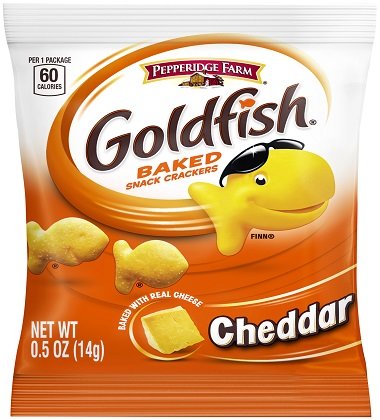
Let’s take a closer look at the label of Goldfish Cheddar Crackers (bolded emphasis are mine, for ingredients I’ll discuss in detail below):
“MADE WITH SMILES AND ENRICHED WHEAT FLOUR (FLOUR, NIACIN, REDUCED IRON, THIAMINE MONONITRATE, RIBOFLAVIN, FOLIC ACID), CHEDDAR CHEESE ([CULTURED MILK, SALT, ENZYMES], ANNATTO), CANOLA AND/OR SUNFLOWER OILS, CONTAINS 2 PERCENT OR LESS OF: SALT, YEAST, SUGAR, AUTOLYZED YEAST, BAKING SODA, MONOCALCIUM PHOSPHATE, PAPRIKA, SPICES, CELERY, ONION POWDER. CONTAINS: WHEAT, MILK.”
Longtime readers of this blog know that I am gluten-free, based on a significant amount of evidence about gluten and its negative impact on our health. Enriched wheat flour contains gluten, which:
In Goldfish Crackers we are getting gluten in the form of enriched flour, which means that the original whole grain was stripped of its nutrients and after refining, was then fortified with vitamins and minerals. The problem with this is that these manufactured vitamins and minerals are not forms that our bodies can recognize and use, compared to if we’d just eaten the whole food source. You can read more about the dangers of white, refined and enriched flours here.
Like gluten, dairy is one of those ingredients that isn’t beneficial for our health. There is a lot of healthwashing around dairy, with the dairy industry claiming that we need milk products for bone health and overall health. There is also particular emphasis on dairy products for children, insisting that they need dairy for growth. Unfortunately, dairy consumption is linked to:
The quality of cheese and milk products matter, too. If we’re consuming conventional dairy (or conventional animal products of any kind), the health value that companies claim their products contain likely isn’t there. For instance, milk from grass-fed cows is higher in anti-inflammatory omega-3 fats and organic milk has a lower ratio of omega-6 to omega-3s (we want that lower ratio for its anti-inflammatory benefits). In one study comparing cheeses made from the milk of grass-fed (alpine) cows to regular cows, researchers found that the alpine cheeses were also higher in omega-3s and contained a better fatty acid profile.
In 2018, Pepperidge Farms, the maker of Goldfish Crackers, recalled four different types of its cheese crackers because of possible salmonella contamination in the whey powder used. While food recalls can really happen in any type of product or ingredient, from spinach to peanut butter, it’s not often that you see a dried good like a cracker being recalled. And children – the ones who are likely eating the crackers – can sometimes be more sensitive than the general population.
If we are looking for good sources of fat and protein for growing children, there are tons of other options including:
You can also read my full breakdown of what I fed my son Finn for the first year of his life in my post about baby food introductions and meal ideas.
It always baffles me when food labels list ‘and/or’ with respect to oils. Is there canola oil in this product? Sunflower oil? A mix of both? Why can’t they tell me for sure?
Aside from the oil source vagueness, canola oil is most likely genetically modified unless otherwise specified. To give Goldfish Crackers some credit, they do list which ingredients and products come from GMO sources so at least we, as consumers, are informed and can make a choice (Pepperidge Farms uses GMOs because the company believes they are safe).
When choosing your oils, you have to ask yourself: does this oil come from a naturally oily source? Olives, coconuts, butter – they’re oily. Canola? Not so oily. That means a heck of a lot of processing needs to happen in order to turn canola into an oil. Canola oil and sunflower oil are highly industrialized and processed, plus they are very high in omega-6 fats – these are pro-inflammatory in the body.
The next four ingredients fall under this category, but I’m still listing my concerns about them. Even though these ingredients are present in small amounts, what is the cumulative effect of them when you are eating Goldfish Crackers daily? Remember, some families are going through as many as eight bags of Goldfish Crackers a month! If you’re eating them once or twice a year, these probably aren’t going to have a major effect. But that is not the case for many families.
This is typically code for monosodium glutamate (MSG), a food additive often used in processed foods. It’s a highly addictive excitotoxin that can affect the brain, induce headaches and aggravate IBS. You can read more detail about MSG and other ingredients kids should avoid eating here.
These crackers are a source of a small amount of sugar. Given the highly deleterious effects of sugar, do we really need to add more of it to kids’ savory crackers?
This ingredient is used as a leavener to help baked goods rise. Some evidence indicates that phosphate additives can be harmful to those with renal diseases and cardiovascular problems, but may also be damaging to the general population due to the widespread use of these additives in processed foods.
Which spices are these? People with food allergies need to know what these are. For example, I have an allergy to black pepper – is this included in the mix of spices? Also, most spices are irradiated – food irradiation destroys the nutrients in foods and the jury is still out about how safe this process is to us.
Smiles! I will happily consume all the smiles they can squeeze into anything – I just don’t want to eat the rest. Neither should you. And you may want to rethink giving these to the little people whose smiles you love most.
If you take a gander at the Pepperidge Farm website, you might be lulled into thinking that Goldfish Crackers aren’t so bad. Some of the claims they make about their products include:
During the last 15+ years of my business, I’ve worked hard to challenge companies on their ingredients and have asked them to do better. For large conglomerates, change can be painful and slow. However, in the last several years there has been a sea of change based on consumer demand for companies to eliminate dangerous food colours, preservatives, added sugars, GMOs and other harmful ingredients. This is definitely a positive thing.
However, making something healthier doesn’t automatically make it healthy. Companies are capitalizing on healthwashing claims such as ‘natural’, ‘contains omega-3s’, ‘made with real cheese’, and more in the hopes that these vague terms will add a health halo to their products. We are highly susceptible to marketing – it’s even happened to me – and package claims don’t always equal a nutritious choice.
For me, Goldfish Crackers just aren’t a health-promoting food.
I have written about the toxic ingredient in Monsanto’s RoundUp Ready pesticide at length. We likely all heard the story of the school groundskeeper who won a $280 million dollar lawsuit against Monsanto where their product RoundUp was implicated in his terminal cancer. Well, a recent report has shown that there are unsafe levels of glyphosate residue on a host of commercially made snack breakfast cereals and snack foods including Pepperidge Farms Goldfish Crackers.

The health implications of glyphosate are astounding and horrifying. How can this be so pervasive in our food system? For the full details, I strongly recommend you review this report in detail.
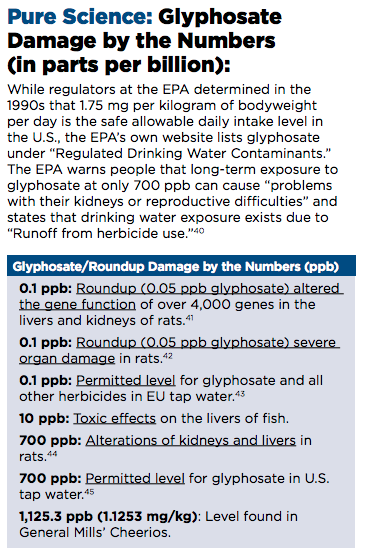
Though you may look at the above chart and shrug it off Goldfish, after all, seem to be within the safe range, right? What about the total consumption from all of our food and drinking water? What about the bioaccumulation – the cumulative effect of a week eating foods containing glyphosate, or a month, or the entire lifetime of a five-year-old, whose body weight is a quarter of that of a fully grown adult?
When it comes to Goldfish Crackers, feeding these chemicals to our kids is simply too easy. Too convenient. Never worth it.
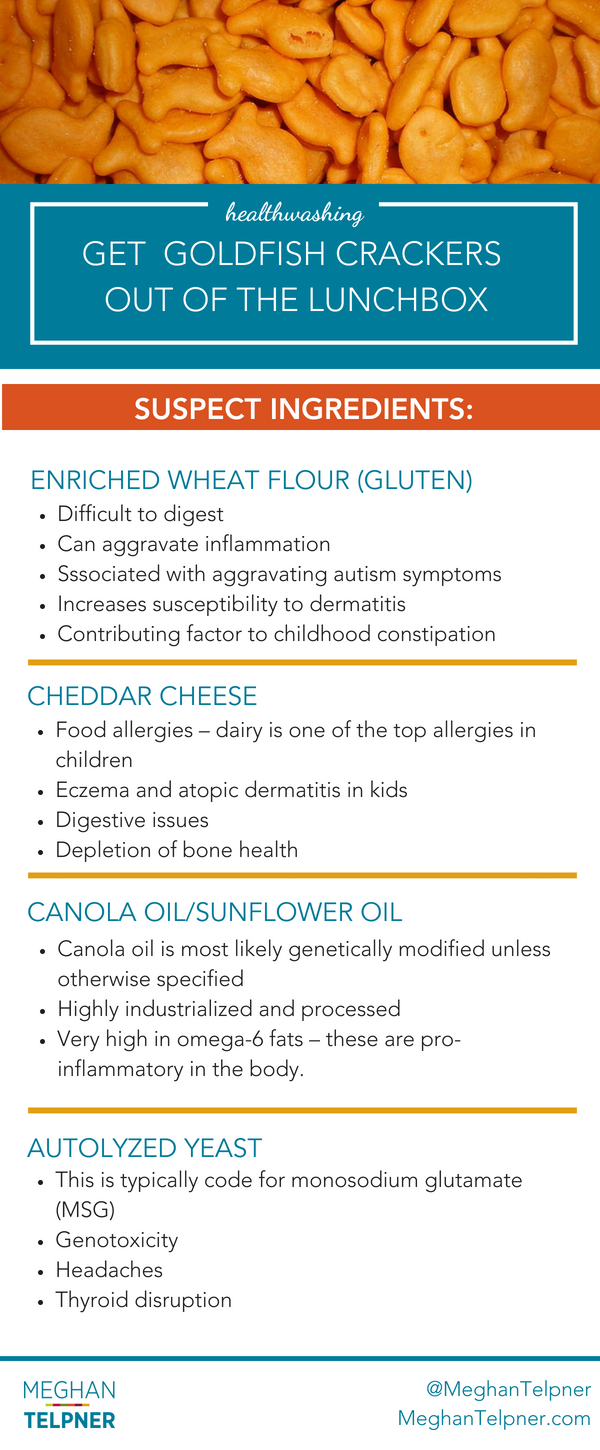
Eating organic for just one week reduces pesticide intake by 90%. Let’s start there. Sure, there is no longer a way to 100% avoid the chemicals in our food, but there are ways to dramatically reduce it. Look at ingredient labels. Get to know the details. It doesn’t matter what a package says isn’t in the product. Get to know what is actually in there.
When choosing alternatives, look out for:
In my opinion, crackers are just a vehicle for scooping up delicious dips and hummus recipes. Goldfish Crackers are far too small for this, meaning they are mainly eaten on their own. Pairing a cracker with vegetables, protein, and fat helps to balance blood sugar levels and keeps us feeling satiated. This is super important for kiddos spending a long day at school, where they need to be in the right mindset to learn and grow.
These gluten-free and vegan homemade crackers are great alternatives – and you can even get your kids to help make them.
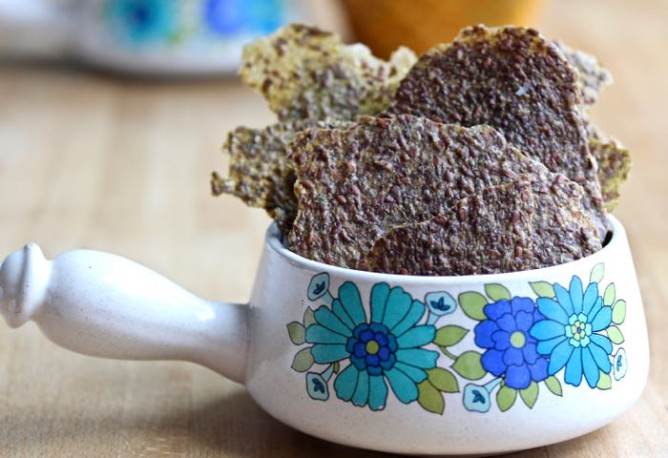
Deliciously crunchy and grain-free.
GET THE RECIPE
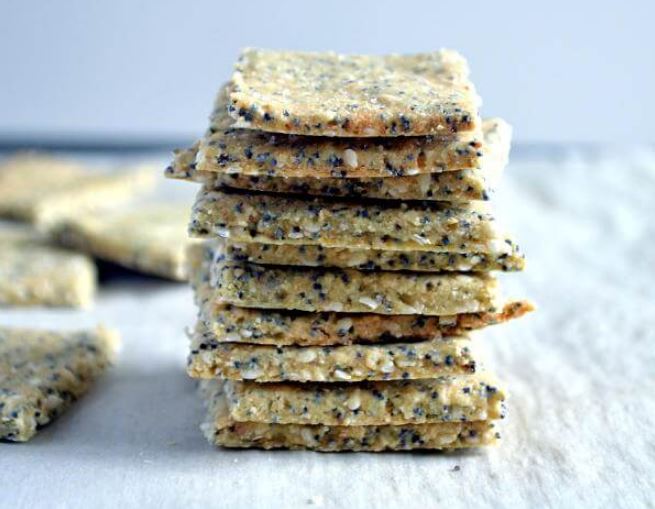
By Sondi Bruner
All of the seasonings are baked into the crackers, so nothing falls off.
GET THE RECIPE

By Strength and Sunshine
If you want to make the effort with a goldfish-shaped cookie cutter, this recipe is gluten-free, grain-free, vegan and allergen-friendly.
GET THE RECIPE
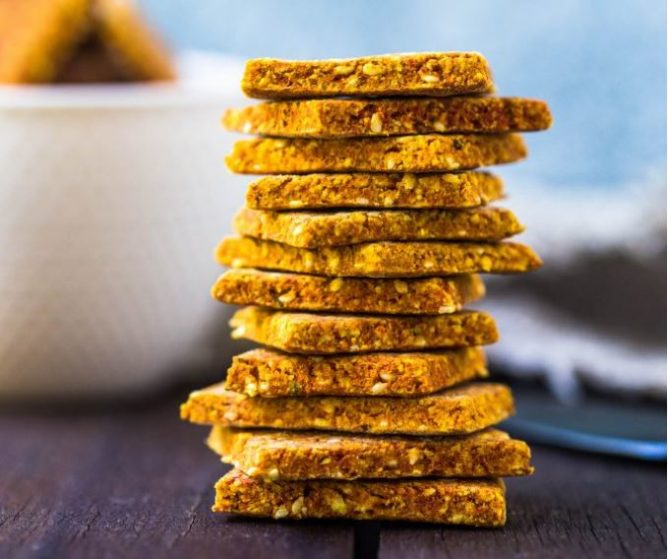
By Wholesome Patisserie
These cheesy-ish crackers also offer the health benefits of turmeric.
GET THE RECIPE
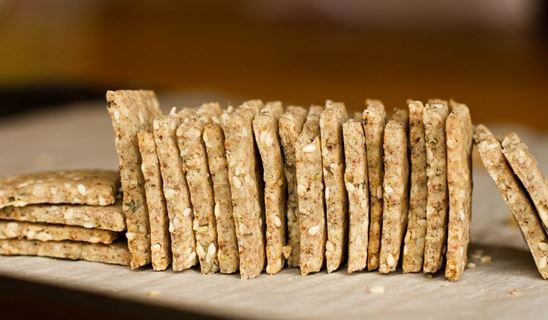
By Oh She Glows
These ones are super easy to customize with different herbs and spices.
GET THE RECIPE
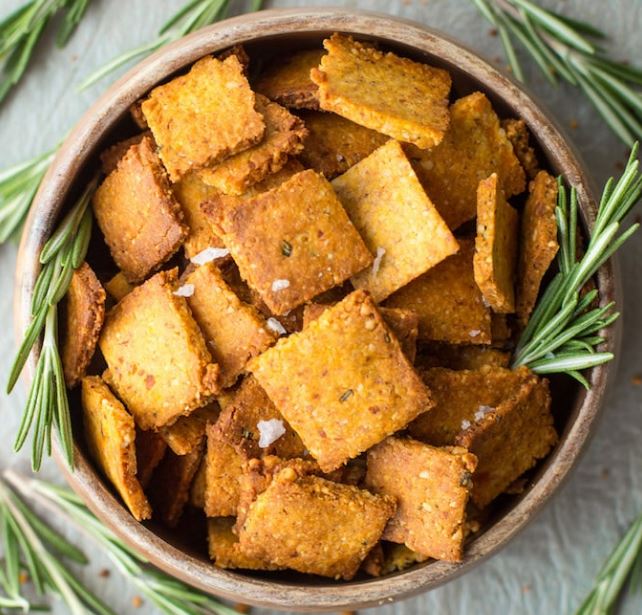
By A Saucy Kitchen
Sweet potatoes and almonds combine to make these delectable grain-free crackers.
GET THE RECIPE
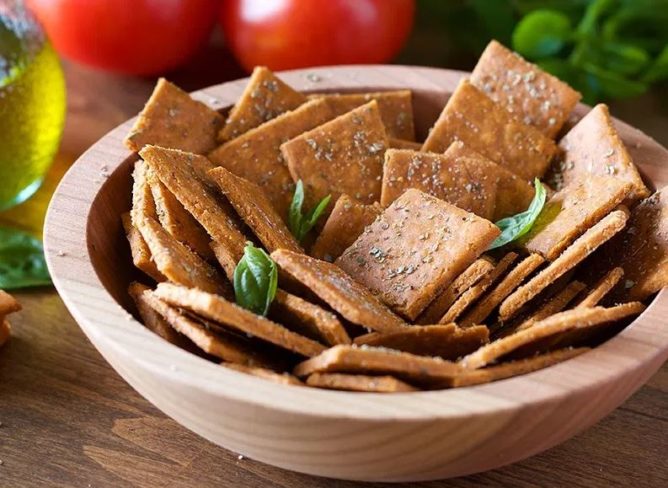
by Living Healthy With Chocolate
Tasty crackers made with cassava flour – a great Paleo flour to experiment with.
GET THE RECIPE
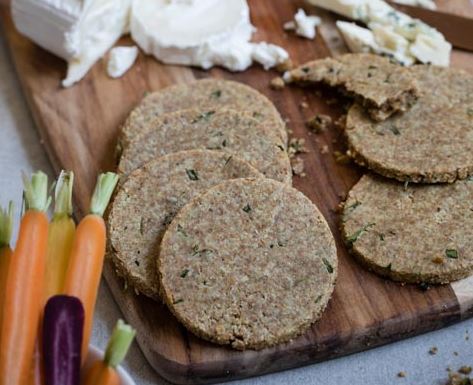
By Keto Diet App
Herby crackers for those who are following a ketogenic diet.
GET THE RECIPE
What if we ditched the crackers altogether? What would that look like? Try:
I know that many of you may feel inclined to defend your choice. I get it. Goldfish Crackers are easy. They come in a package, they’re cute, they keep your kid occupied, all their friends have them… but are these actual good reasons? This goes beyond a healthy choice versus a treat. These crackers and their processed brothers and sisters contain ingredients and chemicals not listed on the ingredients label that have serious long-term, cumulative health effects that can’t be ignored.
If you’re curious about other ingredients that don’t belong in your diet, or that of your kids, check out this post.
The post Why Goldfish Crackers Don’t Belong In A Lunch Box appeared first on Meghan Telpner.